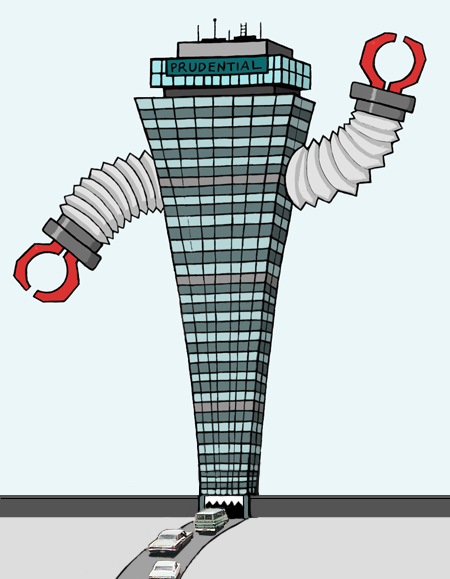RICHARD S. DARGAN | Architecture
Prudential Center Tower, Boston
| |||||||
 |
Completed: 1964 With its metallic color scheme and shimmering observation deck, the Prudential Tower (the Pru) evokes the Space Age 60s. The building often has been likened to the "danger Will Robinson!" robot from the short-lived 1960s TV show Lost in Space. Hovering over the spot where the Massachusetts Turnpike dives under Copley Square, it seems poised to devour cars heading into the city. In fact, the Pru is inextricably linked with postwar American car culture. Yale University architecture professor Elihu Rubin's excellent book, Insuring the City: The Prudential Tower and the Postwar Urban Landscape, describes how the insurance company partnered with the Massachusetts Turnpike authority to build the complex over an old rail yard concurrently with construction of the Turnpike's extension into the city. According to Rubin, the Pru was part of a nationwide effort by insurance companies to assert themselves on the urban landscape and restore the viability of American cities in the face of suburbanization. The Pru's rectangular tower features aluminum framed curtain walls attached to a steel central structure. Architect Luckman designed it in the International Style, and its alternating strips of reflective glass and aluminum hearken back to one of the form's enduring expressions: the United Nations Secretariat building in New York City. The tower is the salient feature of a multi-faceted development that includes a plaza and underground garage. Luckman's firm was known known for the prominence of their projects (e.g., 9200 Sunset, Madison Square Garden) if not the artistry, and the Prudential Center was no different. It elicited criticism from the very beginning for its lack of harmony with the surrounding neighborhood. In fairness, how often do you see a skyscraper that reflects the neighborhood around it? The best that you can hope for is something with a stand-alone presence, like the Hancock Tower. While the Pru may not have achieved the Hancock's reputation in architectural circles, it compares favorably with many of its contemporaries, including Luckman's Aon Center in Los Angeles.
|
||||||